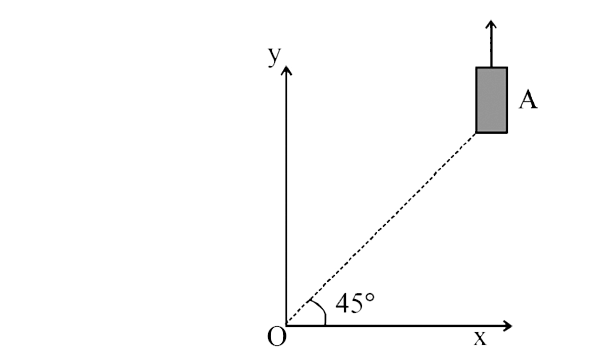Let ABC be an equilateral triangle inscribed in the circle x2+y2=a2 . Suppose pendiculars from A, B, C to the ellipse x2a2+y2b2=1,(a>b) meets the ellipse respectivelily at P, Q, R so that P, Q , R lies on same side of major axis as A, B, C respectively. Prove that the normals to the ellipse drawn at the points P Q nad R are concurrent.
The correct Answer is:A, B, C, D
To solve the problem, we need to prove that the normals to the ellipse at points P, Q, and R are concurrent. Here's a step-by-step solution:
Step 1: Understand the Setup
We have an equilateral triangle ABC inscribed in the circle defined by the equation x2+y2=a2. The points A, B, and C can be represented in parametric form as:
- A(acosθ,asinθ)
- B(acos(θ+2π3),asin(θ+2π3))
- C(acos(θ+4π3),asin(θ+4π3))
Step 2: Find the Coordinates of Points P, Q, and R
The perpendiculars from points A, B, and C to the ellipse x2a2+y2b2=1 meet the ellipse at points P, Q, and R. The coordinates of these points can be expressed as:
- P(acosθ,bsinθ)
- Q(acos(θ+2π3),bsin(θ+2π3))
- R(acos(θ+4π3),bsin(θ+4π3))
Step 3: Derive the Normal Equations
The normal to the ellipse at a point (x0,y0) is given by the equation:
x0a2(x−x0)+y0b2(y−y0)=0
Using this formula, we can write the equations of the normals at points P, Q, and R.
1. Normal at P:
acosθa2(x−acosθ)+bsinθb2(y−bsinθ)=0
Simplifying gives:
cosθa(x−acosθ)+sinθb(y−bsinθ)=0
2. Normal at Q:
acos(θ+2π3)a2(x−acos(θ+2π3))+bsin(θ+2π3)b2(y−bsin(θ+2π3))=0
3. Normal at R:
acos(θ+4π3)a2(x−acos(θ+4π3))+bsin(θ+4π3)b2(y−bsin(θ+4π3))=0
Step 4: Show Concurrency
To show that the normals are concurrent, we can use the determinant method. We set up a determinant using the coefficients of x and y from the normal equations.
Let the equations of the normals be:
1. A1x+B1y+C1=0
2. A2x+B2y+C2=0
3. A3x+B3y+C3=0
The normals are concurrent if the determinant:
∣∣
∣∣A1B1C1A2B2C2A3B3C3∣∣
∣∣=0
Step 5: Calculate the Determinant
Calculating the determinant will involve substituting the coefficients from the normal equations derived in Step 3. If the determinant evaluates to zero, it confirms that the normals are concurrent.
Conclusion
Thus, we have shown that the normals to the ellipse at points P, Q, and R are concurrent.
We have an equilateral triangle ABC inscribed in the circle defined by the equation x2+y2=a2. The points A, B, and C can be represented in parametric form as:
- A(acosθ,asinθ)
- B(acos(θ+2π3),asin(θ+2π3))
- C(acos(θ+4π3),asin(θ+4π3))
The perpendiculars from points A, B, and C to the ellipse x2a2+y2b2=1 meet the ellipse at points P, Q, and R. The coordinates of these points can be expressed as:
- P(acosθ,bsinθ)
- Q(acos(θ+2π3),bsin(θ+2π3))
- R(acos(θ+4π3),bsin(θ+4π3))
The normal to the ellipse at a point (x0,y0) is given by the equation:
x0a2(x−x0)+y0b2(y−y0)=0
Using this formula, we can write the equations of the normals at points P, Q, and R.
acosθa2(x−acosθ)+bsinθb2(y−bsinθ)=0
Simplifying gives:
cosθa(x−acosθ)+sinθb(y−bsinθ)=0
acos(θ+2π3)a2(x−acos(θ+2π3))+bsin(θ+2π3)b2(y−bsin(θ+2π3))=0
acos(θ+4π3)a2(x−acos(θ+4π3))+bsin(θ+4π3)b2(y−bsin(θ+4π3))=0
To show that the normals are concurrent, we can use the determinant method. We set up a determinant using the coefficients of x and y from the normal equations.
1. A1x+B1y+C1=0
2. A2x+B2y+C2=0
3. A3x+B3y+C3=0
∣∣
∣∣A1B1C1A2B2C2A3B3C3∣∣
∣∣=0
Calculating the determinant will involve substituting the coefficients from the normal equations derived in Step 3. If the determinant evaluates to zero, it confirms that the normals are concurrent.
Thus, we have shown that the normals to the ellipse at points P, Q, and R are concurrent.
Topper's Solved these Questions
- ELLIPSEBOOK - ARIHANT MATHS ENGLISHCHAPTER - ELLIPSEEXERCISE - Example
4 Videos
- ELLIPSEBOOK - ARIHANT MATHS ENGLISHCHAPTER - ELLIPSEEXERCISE - Exercise For Session 1
18 Videos
- DY / DX AS A RATE MEASURER AND TANGENTS, NORMALS BOOK - ARIHANT MATHS ENGLISHCHAPTER - DY / DX AS A RATE MEASURER AND TANGENTS, NORMALS EXERCISE - Exercise (Questions Asked In Previous 13 Years Exam)
7 Videos
- ESSENTIAL MATHEMATICAL TOOLS BOOK - ARIHANT MATHS ENGLISHCHAPTER - ESSENTIAL MATHEMATICAL TOOLS EXERCISE - Exercise (Single Integer Answer Type Questions)
3 Videos
Similar Questions
A tangent to the ellipse x2+4y2=4 meets the ellipse x2+2y2=6 at P&Q.
View SolutionIf the normal at point P(θ) on the ellipse x2a2+y2b2=1 meets the axes of xandy at MandN respectively, show that PM:PN=b2:a2.
View SolutionProve that the area bounded by the circle x2+y2=a2 and the ellipse x2a2+y2b2=1 is equal to the area of another ellipse having semi-axis a−b and b,a>b .
View SolutionA square is inscribed inside the ellipsex2a2+y2b2=1, the length of the side of the square is
View SolutionThe line x=at2 meets the ellipse x2a2+y2b2=1 in the real points iff
View SolutionP and Q are corresponding points on the ellipse x2a2+y2b2=1 and the auxiliary circle respectively . The normal at P to the elliopse meets CQ at R. where C is the centre of the ellipse Prove that CR = a +b
View SolutionIf normal at any point P to ellipse x2a2+y2b2=1(a>b) meet the x & y axes at A and B respectively. Such that PAPB=34 , then eccentricity of the ellipse is:
View SolutionOn a frictionless horizontal surface , assumed to be the x−y plane , a small trolley A is moving along a straight line parallel to the y−axis ( see figure) with a constant velocity of (√3−1)m/s . At a particular instant , when the line OA makes an angle of 45(∘) with the x− axis , a ball is thrown along the surface from the origin O. Its velocity makes an angle ϕ with the x− axis and it hits the trolley .
(a) The motion of the ball is observed from the frame of the trolley . Calculate the angle θ made by the velocity vector of the ball with the x−axis in this frame .
(b) Find the speed of the ball with respect to the surface , if ϕ=(4θ)/(3).

View Solutiontangent drawn to the ellipse x2a2+y2b2=1 at point 'P' meets the coordinate axes at points A and B respectively.Locus of mid-point of segment AB is
View SolutionIf P(θ),Q(θ+π2) are two points on the ellipse x2a2+y2b2=1 and α is the angle between normals at P and Q, then
View Solution
